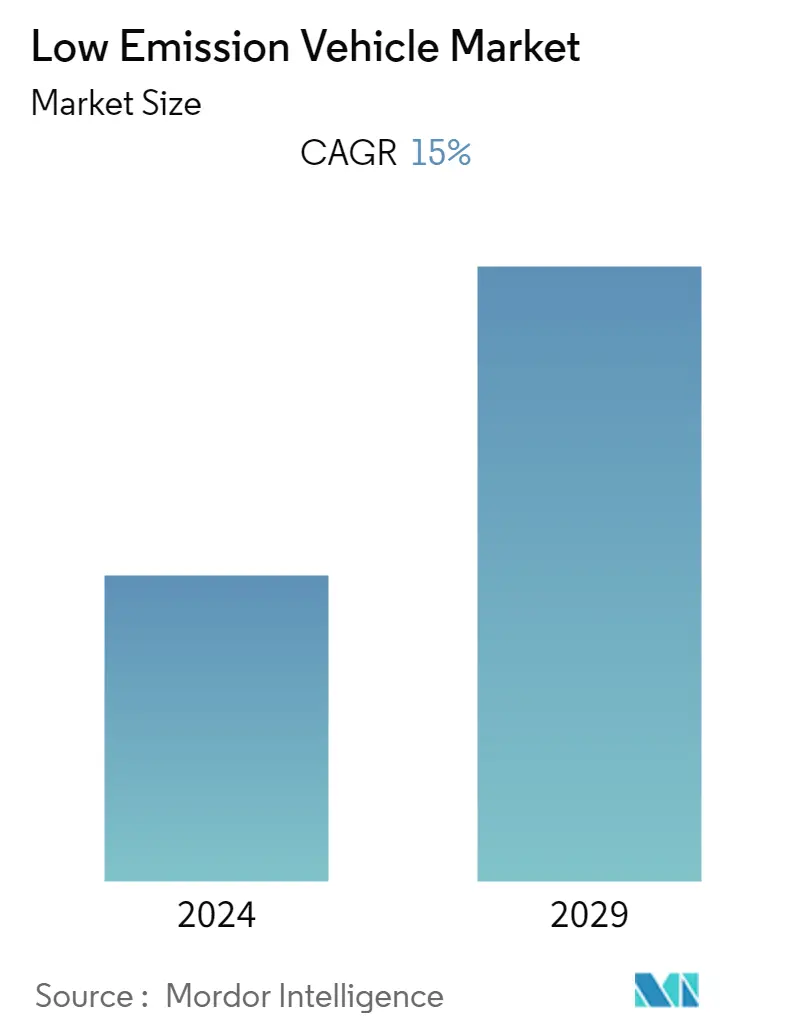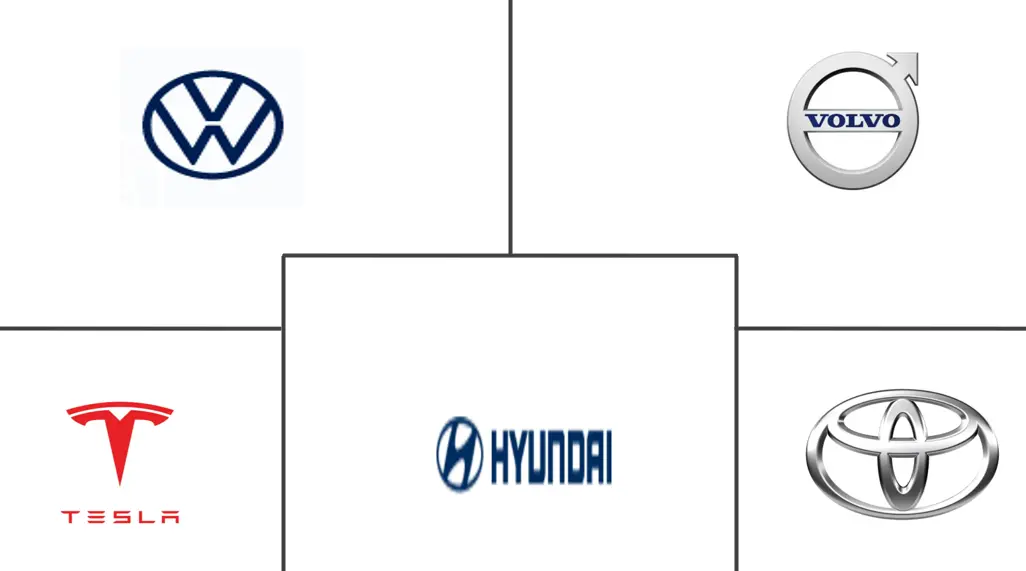Market Size of Low Emission Vehicle Industry

| Study Period | 2019 - 2029 |
| Base Year For Estimation | 2023 |
| CAGR | 15.00 % |
| Fastest Growing Market | Asia-Pacific |
| Largest Market | North America |
| Market Concentration | High |
Major Players
*Disclaimer: Major Players sorted in no particular order |
Low-Emission Vehicle Market Analysis
The low-emission vehicle market is valued at USD 126 billion in the current year. The market is expected to reach USD 292 billion by the next five years, registering a CAGR of 15% in revenue during the forecast period.
- During the lockdowns, the COVID-19 pandemic compelled about 95% of all automotive companies to put their workforces on hold. Globally, the repercussions of the lockdown have been immense and unprecedented in the automotive sector due to the halt of manufacturing activities. However, the market has regained momentum as economic activities resume and vehicle production also rises worldwide.
- Over the medium term, Government policies to support the growth of electric vehicles and plans to enlarge the electric vehicle charging infrastructure are expected to remain prominent market drivers during the forecast period. Several regional governments have announced their plans to have a certain portion of their new vehicle sales be electric in the upcoming few years.
- Electric car sales reached a record 3 million in 2020, up 40% from 2019. This strong growth was a stark contrast to general car market sluggishness globally, with overall car sales down 16% due to the Covid-19 crisis. After a decade of rapid growth, over 10 million electric cars are on the road, representing ~1% of the global car stock. For 2030, the Net Zero Emissions by 2050 Scenario projects 300 million electric cars on the road, accounting for over 60% of new car sales, compared with only 4.6% in 2020. Early market data for 2021 sales suggests rapid growth in significant markets.
- The electric vehicle (EV) market witnessed significant growth due to the need to address future energy requirements. The need to attain sustainable transportation is vital in driving electric vehicle demand.
- The electric vehicle market is becoming an integral part of the automotive industry. It represents a pathway toward achieving energy efficiency, along with reduced emissions of pollutants and other greenhouse gases. Increasing environmental concerns and favorable government initiatives are some of the major factors driving the market growth. Rising energy costs and competition among emerging energy efficiency technologies are also expected to fuel the market growth.
Low-Emission Vehicle Industry Segmentation
A low-emission vehicle is a motor vehicle that emits relatively low levels of emissions from the motor vehicle. Low-emission vehicles are the one that doesn't emit as much nitrous oxide (NOx) and carbon dioxide (CO2) pollution from the vehicle.
The low-emission vehicle market has been segmented by type, vehicle type, and geography. Based on the type, the market is segmented into hybrid, mild hybrid, and Pure Electric Vehicle. Based on the vehicle ype, the market is segmented into passenger cars and commercial vehicles. Based on geography, the market is segmented into North America, Europe, Asia-Pacific, and the Rest of the World.
For each segment, the market sizing and forecast have been done based on the value (USD billion).
| Vehicle Type | |
| Passenger Car | |
| Commercial Vehicles |
| Type | |
| Hybrid | |
| Mild Hybrid | |
| Pure Electric Vehicle |
| Geography | ||||||||
| ||||||||
| ||||||||
| ||||||||
|
Low Emission Vehicle Market Size Summary
The low-emission vehicle market is experiencing robust growth, driven by increasing environmental concerns and supportive government policies worldwide. The market is characterized by a significant shift towards electric vehicles (EVs), which are becoming an integral part of the automotive industry. This transition is fueled by the need for sustainable transportation solutions that enhance energy efficiency and reduce greenhouse gas emissions. The market's expansion is further supported by initiatives such as the development of extensive EV charging infrastructure and regulatory measures aimed at promoting electric vehicle adoption. Countries like China, the United States, and several European nations are leading the charge with favorable policies, financial incentives, and stringent emissions standards, which are pivotal in driving the market forward.
The market landscape is populated by both established automotive giants and emerging startups, with key players like BYD, Tesla, and Volkswagen AG at the forefront. These companies are actively expanding their electric vehicle offerings and investing in new technologies to meet the growing demand. Government initiatives, such as India's FAME policies and China's stringent quotas on combustion-engine vehicles, are creating a conducive environment for market growth. Additionally, significant investments in EV manufacturing and infrastructure development are being observed globally, with countries like Thailand and Malaysia making substantial strides in expanding their electric vehicle networks. As a result, the low-emission vehicle market is poised for significant growth, with a promising outlook for the coming years.
Low Emission Vehicle Market Size - Table of Contents
-
1. MARKET DYNAMICS
-
1.1 Market Drivers
-
1.2 Market Restraints
-
1.3 Porters 5 Force Analysis
-
1.3.1 Threat of New Entrants
-
1.3.2 Bargaining Power of Buyers/Consumers
-
1.3.3 Bargaining Power of Suppliers
-
1.3.4 Threat of Substitute Products
-
1.3.5 Intensity of Competitive Rivalry
-
-
-
2. MARKET SEGMENTATION (Market Size by Value - USD billion)
-
2.1 Vehicle Type
-
2.1.1 Passenger Car
-
2.1.2 Commercial Vehicles
-
-
2.2 Type
-
2.2.1 Hybrid
-
2.2.2 Mild Hybrid
-
2.2.3 Pure Electric Vehicle
-
-
2.3 Geography
-
2.3.1 North America
-
2.3.1.1 United States Of America
-
2.3.1.2 Canada
-
2.3.1.3 Mexico
-
2.3.1.4 Rest of North America
-
-
2.3.2 Europe
-
2.3.2.1 Germany
-
2.3.2.2 United Kingdom
-
2.3.2.3 France
-
2.3.2.4 Italy
-
2.3.2.5 Spain
-
2.3.2.6 Rest of Europe
-
-
2.3.3 Asia-Pacific
-
2.3.3.1 India
-
2.3.3.2 China
-
2.3.3.3 Japan
-
2.3.3.4 South Korea
-
2.3.3.5 Rest of Asia-Pacific
-
-
2.3.4 Rest of the World
-
2.3.4.1 Brazil
-
2.3.4.2 Saudi Arabia
-
2.3.4.3 United Arab Emirates
-
2.3.4.4 South Africa
-
-
-
Low Emission Vehicle Market Size FAQs
What is the current Low Emission Vehicle Market size?
The Low Emission Vehicle Market is projected to register a CAGR of 15% during the forecast period (2024-2029)
Who are the key players in Low Emission Vehicle Market?
Tesla Inc, Volkswagen AG, Toyota Motor Corporation, Hyundai Motor Company and AB Volvo are the major companies operating in the Low Emission Vehicle Market.

